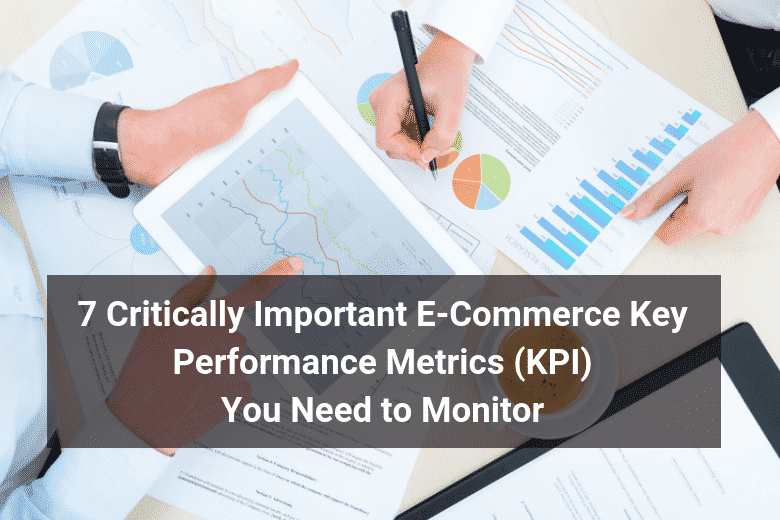To optimize your e-commerce business’s marketing and sales strategy, you must monitor performance indicators (KPIs). Only then will you know which methods work and which ones don’t. Unfortunately, many e-commerce businesses focus strictly on net revenue while overlooking other, more meaningful KPIs. To succeed in the highly competitive e-commerce industry, you must look beyond net revenue by regularly monitoring the seven following KPIs.
1) Average Order Value
Average order value (AOV) reveals the average amount of money customers spend when placing an order with your e-commerce business. It’s calculated by dividing your business’s total sales revenue by its total number of orders for a given time period. If your business generated $12,000 in sales from 150 orders last month, for example, your AOV for that month would be $80. In other words, customers spent an average of $80 per order.
A simple way to increase your e-commerce business’s AOV is to upsell and cross-sell. Upselling involves promoting more expensive products to shoppers, whereas cross-selling involves promoting related products or add-ons to shoppers. Both tactics can drive a higher AOV by encouraging customers to spend more money per order.
2) Customer Lifetime Value
You can project the monetary value of your e-commerce business’s customers using customer lifetime value (CLV). This KPI reveals the average sales revenue a typical customer will bring to your business during the course of his or her relationship with your business.
To calculate CLV, take your e-commerce business’s AOV and multiply it by your average purchase frequency. Next, take this number and multiply it by your business’s average customer lifespan in years. By monitoring your e-commerce business’s CLV, you’ll have a better understanding of how much revenue each customer will bring to your business.
3) Shopping Cart Abandonment Rate
Shopping cart abandonment rate reveals the percentage of shoppers who added at least one product to their cart but didn’t follow through with the checkout process. Statistics show e-commerce websites have an average shopping cart abandonment rate of 60 percent to 80 percent, meaning up to four in five online shoppers don’t submit their payment information after adding a product to their cart.
Most e-commerce platforms display shopping cart abandonment rate, as well as other KPIs, in the analytics section of their dashboard. You can manually calculate this KPI, however, by dividing your e-commerce business’s total number of orders by its total number of carts created and then multiplying this number by 100. If your business processed 1,500 orders last year but had 4,000 carts created, your shopping cart abandonment rate for that year would be 37.5 percent.
Some of the most common reasons for a high shopping cart abandonment rate include:
- Checkout process requires registration
- Security or privacy concerns
- Limited number of supported payment methods
- High shipping costs
- Technical errors with website
- Unsatisfactory return policy
4) Conversion Rate
Even if you’re unfamiliar with AOV, CLV and shopping cart abandonment rate, you’ve probably heard of conversion rate. It’s arguably the most important KPI for e-commerce businesses because it reveals the percentage of visitors to your online store who make a purchase. A low conversion rate indicates shoppers are leaving your e-commerce website without making a purchase.
Conversion rate can be calculated either for your entire e-commerce website or specific product pages, and you can also calculate it for specific traffic sources like pay-per-click (PPC) or organic search. To calculate conversion rate, divide the total number of orders generated by your website or a product page during a specific time period by its total number of visitors and multiply this number by 100. If a product page attracted 3,000 visitors last month and generated 120 orders, your conversion rate for that month would be 4 percent.
5) Mobile Traffic
Mobile traffic accounts for roughly one-third of all e-commerce transactions, making this a critically important KPI to monitor. To find out how many shoppers access your e-commerce website from a mobile device, use Google Analytics.
After adding your website to Google Analytics, click the “Audience” tab on the left sidebar menu, followed by “Mobile” and “Overview.” Google Analytics will then display a breakdown of your website’s traffic by device. If the total of your “tablet” and “mobile” traffic is less than 30 percent, consider updating your website’s design to provide shoppers with a more mobile-friendly experience.
6) Customer Acquisition Cost
Customer acquisition cost (CAC) reflects the average cost of acquiring a new customer to your e-commerce business. To calculate CAC, add up the total amount of money your e-commerce business spent on marketing and sales activities during a specific time period and divide that number by the total number of new customers who made a purchase during that same period. If your business spent $500 on marketing and sales last month and attracted 50 new customers, your the CAC for that month would be $10.
A good rule of thumb is to maintain a CAC that’s lower than your CLV. If your CAC is higher than your CLV, you are spending too much money on marketing and sales. By keeping your CAC lower than your CLV, you’ll have a profitable e-commerce business in which you generate more revenue than the amount of money you spend on marketing and sales.
7) Return Rate
Processing returns is time consuming and exhaustive, but it comes with the territory when running an e-commerce business. In fact, statistics show 30 percent of all products purchased online are returned. You can track the percentage of your e-commerce business’s customers who return orders using return rate.
To calculate return rate, divide the total number of returns processed by your e-commerce business during a specific time period by the total number of sales orders processed during that same period and multiply that number by 100. If you processed 75 returns and generated 250 sales last month, your return rate for that month would be 30 percent.
Monitoring KPIs alone won’t necessarily help your e-commerce business succeed. You must take action by applying these performance metrics to your optimization efforts. If you discover your website has a high shopping cart abandonment rate, for instance, consider streamlining your checkout process by eliminating unnecessary pages or steps. If you have a high return rate, implement a customer review feature. There are ways to improve poor KPIs, but it’s up to you to take action.
Ready to Go Global?
Running a domestic e-commerce business is one thing, but truly going global is doing e-commerce at a whole new level. Once your business grows, you will likely no longer be able to manage all the incoming orders all by yourself. Storage will need to be expanded, more and more SKU’s will need to be picked and packed, labeled and delivered. Delivered cross-border, worldwide, mind you. At Floship we understand that as an entrepreneur, you much rather focus on growing your business, selling more and coming up with innovative new ideas.
Let Floship handle your e-commerce order fulfillment for you. When you partner with us, we will store your products in our warehouses, in either Hong Kong or Shenzhen, China. Our award-winning software integrates seamlessly with over 65 different e-commerce platforms, such as Shopify, Magento, Amazon and WooCommerce, among others. When orders come in, we automatically receive it and start the pick-pack process. Orders will be shipped in bulk through one of our many logistics partner whom we have price agreements with. This allows you to scale your business while keeping your costs low.
Interested in learning more about our fulfillment services for your e-commerce business? Feel free to reach out, we’d love to understand your business needs better and provide you with a custom solution – because, no company is the same.

Ready To Upgrade Your Logistic Solution?
Speak to Floship ecommerce logistic consultant about improving your global support chain today




